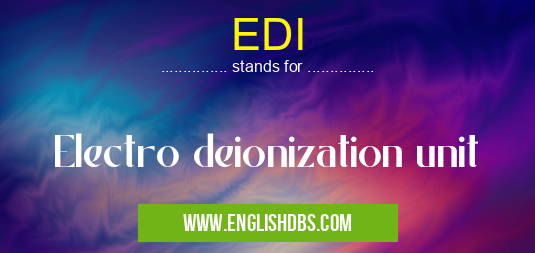What does EDI mean in CHEMISTRY
Electrodeionization (EDI) is a chemical process used in water treatment for the removal of dissolved impurities such as salts and other ions. It is an advanced form of ion exchange technology, which combines filtration and membrane separation to produce high-purity water. EDI has become increasingly popular in recent years due to its numerous advantages over traditional treatments such as reverse osmosis, including better energy efficiency, improved water quality, lower operational costs and ease of use.

EDI meaning in Chemistry in Academic & Science
EDI mostly used in an acronym Chemistry in Category Academic & Science that means Electro deionization unit
Shorthand: EDI,
Full Form: Electro deionization unit
For more information of "Electro deionization unit", see the section below.
Advantages Of Using EDI
The main advantage of using Electrodeionization (EDI) is its ability to produce a high level of purity without using any chemicals or other consumables during operation. It also consumes less energy than conventional treatments such as reverse osmosis or thermal evaporation so it is more cost efficient to operate over time. Additionally, EDI systems do not require regular maintenance since there are no moving parts to wear down or need replacing over time; this makes it a reliable source of clean water production with no downtime needed for repairs or replacements.
Essential Questions and Answers on Electro deionization unit in "SCIENCE»CHEMISTRY"
What is Electro deionization (EDI)?
Electro deionization (EDI) is a water treatment process that removes ions from a solution using an electrical current. In EDI, salts and other impurities are removed by passing electric current through specialized ion exchange membranes. The ions are then replaced with hydrogen or hydroxide ions from the membrane, which purify the water to create pure water without any contaminants.
How does EDI work?
EDI works by using an electrical current to force ions such as salt and other contaminants out of the feedwater and into a series of specialized ion exchange membranes. These membranes allow only certain ions to pass through them while simultaneously replacing them with hydrogen or hydroxide ions. This process ultimately purifies the water to meet your specific purity requirements.
What are the benefits of using EDI?
EDI offers several advantages over traditional water treatment processes including improved system efficiency, reduced chemical costs, reduced wastewater discharge requirements, higher quality effluent, decreased downtime for maintenance and cleaning, and improved system reliability. Additionally, it provides high-quality purified water with minimal effort required for operation and maintenance.
What types of contaminants can be removed by EDI?
EDI can effectively remove most dissolved salts, organic molecules, heavy metals, microorganisms, suspended solids and some volatile organics from the feedwater. It is most commonly used for the removal of hardness salts such as calcium carbonate and magnesium sulfate as well as other common contaminants like nitrates and chlorides.
Does EDI produce waste?
Generally speaking no; though there may be small amounts of residual waste discharged into an effluent stream in some systems depending on individual system design principles. Reject streams from EDI systems tend to be very concentrated so designs that minimize those reject streams often have lower overall environmental impacts than systems relying on chemical regeneration techniques for contaminant removal.
How much energy does EDI require?
The energy required varies depending on the desired level of purification but typically ranges between 1-2 kWh per 1000 gallons treated at 98% recovery rates. Compared to traditional ion exchange processes that require regeneration cycles with chemicals every 3-4 weeks, these energy savings add up significantly over time.
Is EDI a reliable method for purifying water?
Yes; compared to traditional methods such as reverse osmosis or ion exchange processes that require continuous monitoring and maintenance as well as regular regeneration cycles with chemicals every 3-4 weeks (or more frequently), EDI provides reliable purified water with minimal effort required for operation and maintenance - eliminating labor costs associated with conventional process control systems or operator intensive desalination operations.
What types of applications is EDI suitable for?
Due to its ability to effectively remove dissolved salts or other compounds from solution without adding additional chemicals or waste streams into effluent streams - making it an environmentally friendly treatment option - electro deionization has become increasingly popular in industrial settings where there is a need for high purity water products such as semiconductor grade ultrapure water production or pharmaceutical production facilities.
Final Words:
In conclusion, Electrodeionization (EDI) is becoming an increasingly popular method used in water treatment processes due to its numerous advantages including better energy efficiency, lower operational costs and ease of use compared to traditional treatments like reverse osmosis. It requires no chemicals or consumables during operation and maintenance requirements are minimal since there are no moving parts that need regular servicing or replacing over time; making it highly reliable for producing clean drinking water with little downtime required.
